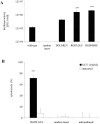Successful expansion but not complete restriction of tropism of adeno-associated virus by in vivo biopanning of random virus display peptide libraries
- PMID: 19357785
- PMCID: PMC2664470
- DOI: 10.1371/journal.pone.0005122
Successful expansion but not complete restriction of tropism of adeno-associated virus by in vivo biopanning of random virus display peptide libraries
Abstract
Targeting viral vectors to certain tissues in vivo has been a major challenge in gene therapy. Cell type-directed vector capsids can be selected from random peptide libraries displayed on viral capsids in vitro but so far this system could not easily be translated to in vivo applications. Using a novel, PCR-based amplification protocol for peptide libraries displayed on adeno-associated virus (AAV), we selected vectors for optimized transduction of primary tumor cells in vitro. However, these vectors were not suitable for transduction of the same target cells under in vivo conditions. We therefore performed selections of AAV peptide libraries in vivo in living animals after intravenous administration using tumor and lung tissue as prototype targets. Analysis of peptide sequences of AAV clones after several rounds of selection yielded distinct sequence motifs for both tissues. The selected clones indeed conferred gene expression in the target tissue while gene expression was undetectable in animals injected with control vectors. However, all of the vectors selected for tumor transduction also transduced heart tissue and the vectors selected for lung transduction also transduced a number of other tissues, particularly and invariably the heart. This suggests that modification of the heparin binding motif by target-binding peptide insertion is necessary but not sufficient to achieve tissue-specific transgene expression. While the approach presented here does not yield vectors whose expression is confined to one target tissue, it is a useful tool for in vivo tissue transduction when expression in tissues other than the primary target is uncritical.
Conflict of interest statement
Figures





Similar articles
-
Heparan Sulfate Binding Promotes Accumulation of Intravitreally Delivered Adeno-associated Viral Vectors at the Retina for Enhanced Transduction but Weakly Influences Tropism.J Virol. 2016 Oct 14;90(21):9878-9888. doi: 10.1128/JVI.01568-16. Print 2016 Nov 1. J Virol. 2016. PMID: 27558418 Free PMC article.
-
Impact of capsid modifications by selected peptide ligands on recombinant adeno-associated virus serotype 2-mediated gene transduction.J Gen Virol. 2012 Oct;93(Pt 10):2131-2141. doi: 10.1099/vir.0.044735-0. Epub 2012 Jul 4. J Gen Virol. 2012. PMID: 22764318
-
How to Successfully Screen Random Adeno-Associated Virus Display Peptide Libraries In Vivo.Hum Gene Ther Methods. 2017 Jun;28(3):109-123. doi: 10.1089/hgtb.2016.177. Epub 2017 Feb 13. Hum Gene Ther Methods. 2017. PMID: 28193101
-
Adeno-associated viral vectors and their redirection to cell-type specific receptors.Adv Genet. 2009;67:29-60. doi: 10.1016/S0065-2660(09)67002-4. Adv Genet. 2009. PMID: 19914449 Review.
-
Generation of Targeted Adeno-Associated Virus (AAV) Vectors for Human Gene Therapy.Curr Pharm Des. 2015;21(22):3248-56. doi: 10.2174/1381612821666150531171653. Curr Pharm Des. 2015. PMID: 26027561 Review.
Cited by
-
New AAV9 engineered variants with enhanced neurotropism and reduced liver off-targeting in mice and marmosets.iScience. 2024 Apr 18;27(5):109777. doi: 10.1016/j.isci.2024.109777. eCollection 2024 May 17. iScience. 2024. PMID: 38711458 Free PMC article.
-
Optimization of design and production strategies for novel adeno-associated viral display peptide libraries.Gene Ther. 2017 Aug;24(8):470-481. doi: 10.1038/gt.2017.51. Epub 2017 Jul 13. Gene Ther. 2017. PMID: 28622288
-
Tropism-modified AAV vectors overcome barriers to successful cutaneous therapy.Mol Ther. 2014 May;22(5):929-39. doi: 10.1038/mt.2014.14. Epub 2014 Jan 28. Mol Ther. 2014. PMID: 24468915 Free PMC article.
-
Rapid evolution of blood-brain-barrier-penetrating AAV capsids by RNA-driven biopanning.Mol Ther Methods Clin Dev. 2020 Dec 23;20:366-378. doi: 10.1016/j.omtm.2020.12.006. eCollection 2021 Mar 12. Mol Ther Methods Clin Dev. 2020. PMID: 33553485 Free PMC article.
-
Identification of AAV variants with improved transduction of human vascular endothelial cells by screening AAV capsid libraries in non-human primates.Gene Ther. 2025 Aug 22. doi: 10.1038/s41434-025-00563-4. Online ahead of print. Gene Ther. 2025. PMID: 40847002
References
-
- Carter BJ. Adeno-associated virus vectors in clinical trials. Hum Gene Ther. 2005;16:541–550. - PubMed
-
- Bessis N, GarciaCozar FJ, Boissier MC. Immune responses to gene therapy vectors: influence on vector function and effector mechanisms. Gene Ther. 2004;11(Suppl 1):S10–17. - PubMed
-
- Zincarelli C, Soltys S, Rengo G, Rabinowitz JE. Analysis of AAV Serotypes 1–9 Mediated Gene Expression and Tropism in Mice After Systemic Injection. Mol Ther 2008 - PubMed
-
- Wu Z, Asokan A, Samulski RJ. Adeno-associated virus serotypes: vector toolkit for human gene therapy. Mol Ther. 2006;14:316–327. - PubMed
Publication types
MeSH terms
Substances
LinkOut - more resources
Full Text Sources
Other Literature Sources

